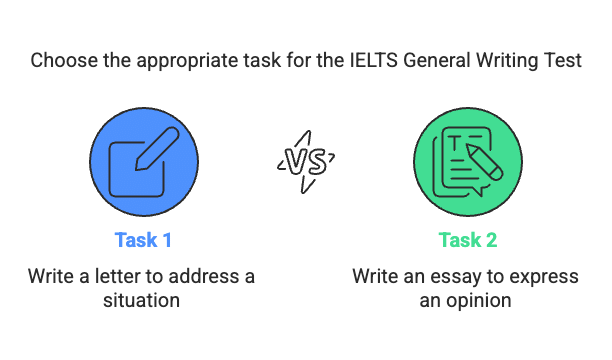The IELTS General Training Writing Test is designed to assess your ability to communicate effectively in everyday, practical situations. It includes two tasks that evaluate both your ability to write a personal or professional letter and to express your opinion in an essay.
1. What is the format of the IELTS General Writing Test?
The test includes two tasks:
Task 1: Write a letter (150 words minimum) in response to a given situation.
Task 2: Write an essay (250 words minimum) expressing an opinion or argument.
You must complete both tasks in 60 minutes.

2. What are the differences between the General and Academic Writing tests?
The main difference is in Task 1:
General Writing Task 1 involves letter writing.
Academic Writing Task 1 involves describing visual data like graphs or charts.
Task 2 (Essay writing) is similar in both, but the General version may have slightly simpler topics and language expectations.
3. How is each task scored?
Each task is scored on four criteria:
Task Achievement
Coherence and Cohesion
Lexical Resource (Vocabulary)
Grammatical Range and Accuracy
Task 2 is worth twice as much as Task 1 in calculating your final Writing band score.
4. What types of letters are there in Task 1?
You may be asked to write:
A formal letter (to someone you don’t know, e.g., a company or government office)
A semi-formal letter (to someone you know in a professional context)
An informal letter (to a friend or family member)
Identifying the tone and using the appropriate language is crucial.
5. How do I know what tone to use in a letter?
The tone depends on who you are writing to:
If the prompt uses words like your friend, write informally.
If it's a manager, a landlord, or a government office, use a formal tone.
If it’s someone you know in a respectful or professional setting, use a semi-formal tone.
Look for clues in the question to guide your choice.
6. How much time should I spend on each task?
It’s recommended to spend:
20 minutes on Task 1 (letter)
40 minutes on Task 2 (essay)
Since Task 2 carries more weight, spend more time planning and refining your essay.
7. What happens if I write fewer words than required?
If you write less than 150 words in Task 1 or less than 250 words in Task 2, you will lose marks under Task Achievement. Always aim to exceed the word limit slightly while staying relevant.
8. Are contractions and informal language allowed?
Yes, but only in informal letters (Task 1). For example, it's acceptable to write “I’m” or “can’t” when writing to a friend. However, avoid contractions and casual expressions in formal letters or essays.
9. What types of essay questions appear in Task 2?
Common essay types include:
Opinion essays (e.g., Do you agree or disagree?)
Discussion essays (e.g., Discuss both views and give your opinion)
Problem-solution essays
Advantages and disadvantages essays
Two-part questions (e.g., Why is this the case? What can be done about it?)
Understanding each type helps you structure your response properly.
10. How can I improve my writing score?
Practice different letter and essay types under timed conditions
Learn to organise ideas clearly using paragraphs
Use a range of vocabulary and grammar accurately
Get feedback from teachers or use model answers to compare
Focus on improving your coherence, transitions, and tone
















